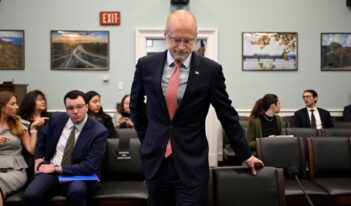
The Supreme Court rejects a nondelegation challenge to the FCC’s power to set universal service fees.
Article I of the Constitution vests Congress with legislative powers, and the principle of nondelegation means that Congress may not give those powers away to other entities. A quarter century ago, after another failed challenge to a sweeping grant of regulatory power to a federal agency, Gary Lawson pronounced the nondelegation doctrine dead. But as every zombie movie fan will tell you, not everything that is dead stays dead. In the U.S. Supreme Court’s 2019 decision Gundy v. United States, Justice Neil Gorsuch, in dissent, launched a blistering attack on the “intelligible principle” test, the cornerstone of the Supreme Court’s nondelegation law for eighty years. The intelligible principle test requires that Congress, when granting regulatory power to the executive branch, provide an “intelligible principle” to guide its exercise of discretion. Gorsuch argued that the test was far too weak and without constitutional foundations, and he proposed instead a much more aggressive approach for policing congressional grants of power. Only four justices stood by the intelligible principle test in Gundy. When the Court accepted review in Federal Communications Commission v. Consumers’ Research, it seemed that another avulsive change to constitutional and administrative law might be coming.
But it was not to be. In a 6–3 decision handed down on June 27, the Court upheld the Federal Communications Commission’s (FCC) authorization under the Federal Communications Act to set the level of contributions that telecommunications carriers must make to a Universal Service Fund (USF). In a time of upheaval for administrative law, the nondelegation doctrine—if never quite dead, as Lawson would have it—remains quiescent for now.
The USF was established by the FCC to satisfy the U.S. Congress’s mandate of universal service—access to telecommunications and information services for all—by subsidizing services for groups and institutions that Congress identified, such as low-income persons, schools, libraries, and rural hospitals. The Federal Communications Act, as amended in 1996, requires that all telecommunications carriers contribute to the USF. The statute leaves it to the FCC to determine covered services and set contribution rates but provides the agency both with criteria for deciding what counts as universal service and guiding principles for the agency to follow. Since 1998, the FCC has tasked a private, non-profit corporation, the Universal Service Administrative Company (USAC), with calculating contribution rates according to a formula devised by the agency.
Speaking of zombies, Consumers’ Research—which was established as a product-testing outfit in 1929 and sold its testing facility in the 1980s—was mostly moribund until five years ago, when it was reanimated as a vehicle for right-wing issue advocacy and cause litigation. Consumers’ Research challenged previous quarterly contributions assessed by the FCC in different federal appeals courts with the same constitutional arguments. Consumers’ Research came up short in the U.S. Courts of Appeals for the Sixth and Eleventh Circuits but hit pay dirt in the Fifth Circuit.
The Fifth Circuit found that the breadth of the delegation in the Federal Communications Act—especially as it involved the power to tax, a core legislative competency—raised “grave concerns.” It further troubled the Fifth Circuit that the contribution amount was formulated entirely outside of the executive branch, as nothing in the statute authorized a subdelegation to USAC. The court was skeptical that the FCC, and not USAC, was calling the shots on administering the USF. The Fifth Circuit ruled neither that the broad delegation in the statute nor the role of USAC was unlawful, but instead held that the combination of these elements was unconstitutional.
The Supreme Court saw things differently. Justice Elena Kagan’s majority opinion was, first and foremost, a ringing reaffirmation of the Court’s nondelegation precedents. Under those precedents, Congress may delegate legislative power to an agency so long as that delegation includes instructions that sufficiently constrain the exercise of that power—the familiar “intelligible principle.” Broader grants of power require more specific guidance.
Leaning further on precedent, Justice Kagan rejected the position that a different test is called for when a delegation involves the power to tax. She also highlighted the nonsensical implications of the challenger’s argument that a congressional cap on fund contributions, and nothing else, could save the statute. Qualitative standards could suffice, Justice Kagan wrote, and the Federal Communications Act positively bristled with guidelines for the FCC when defining the scope of universal service and setting a contribution rate. She noted that four factors and six principles in the statute govern what services are covered, and the statute specifies that the contribution rate should be “sufficient” to support covered services: neither less nor more than is necessary.
Justice Kagan also drew on caselaw to reject the private nondelegation argument: Under controlling precedent, she explained, private recommendations to an agency do not raise constitutional concerns if the agency is the ultimate decider—and, here, it is the FCC, not USAC, that ultimately sets the contribution rate. Finally, Justice Kagan dismantled the Fifth Circuit’s “combination” theory of the constitutional wrong: “A meritless public nondelegation challenge plus a meritless private nondelegation challenge cannot equal a meritorious ‘combination’ claim.”
Justice Brett Kavanaugh, in his concurrence, and Justice Gorsuch, in his dissent, sought to put their spin on the majority’s handiwork.
Justice Kavanaugh, who joined the Court the week after Gundy was argued, came out strongly in favor of the intelligible principle test in his concurrence—but with a caveat. In Justice Kavanaugh’s view, existing doctrine worked for delegations to executive branch agencies, but a different and more stringent approach might be called for when delegations to independent agencies were involved. Justice Kavanaugh rehearsed the reasons why independent agencies now stand under a constitutional cloud, explaining that such delegations—which reduce accountability and attenuate presidential control—interfere with the President’s duties under Article II of the U.S. Constitution. One fix to address these concerns might be to make all agency heads removable, and another might be to require independent agencies to have Congress enact their proposed rules as legislation. But these issues were not implicated in Consumers’ Research, Justice Kavanaugh wrote, because the FCC—whose commissioners do not enjoy statutory protections against at-will removal by the President—is not an independent agency.
Justice Kavanaugh’s concurrence is perhaps best understood as a delivery device for the bombshell suggestion, dropped casually on the last page of his opinion, that independent agencies might not be able to issue their own rules at all. It is worth noting that this suggestion is not directly relevant to the case at hand, as the agency action at issue here is an order, not a rule. Time will tell if other justices are interested in following Justice Kavanaugh down this road.
Justice Gorsuch’s dissent was joined by Justices Clarence Thomas and Samuel Alito. Seeming to accept that the votes are not there to junk the intelligible principle test, Justice Gorsuch argued instead that the Federal Communications Act flunked it. He stressed that the mandatory USF contributions amounted to a tax and suggested that it might, therefore, be constitutionally required for Congress to set the rate. And the qualitative benchmarks Congress provides, in Justice Gorsuch’s view, amount to a “mash” offering no effective constraint on delegated power. Although he was critical of the majority opinion, Justice Gorsuch claimed such small wins as he could find. He noted that the Court did not even try to defend the—in his view, indefensible—provisions allowing the FCC to add its own principles to the ones in the statute, and he also found the majority’s reading of the statute to import more constraints on the FCC than the text fairly implied.
In the end, Consumers’ Research was a case where not much happened. Justice Kagan’s by-the-book opinion presents a case squarely covered by established law. The real story here—and the lingering question of this case—is that a solid majority chose to stand by the law.
Why were two justices—Justice Kavanaugh and Justice Amy Coney Barrett, who also joined the majority—who have shown themselves willing to revisit long-settled constitutional and administrative law doctrines in other contexts, reluctant to take Justice Gorsuch’s invitation to significantly remake nondelegation law, instead joining the majority? Justice Kavanaugh’s concurrence suggests that he, at least, is persuaded that broad delegations have been part of our constitutional practice since the beginning. The justices may also appreciate that alternatives to the current doctrine may prove challenging to administer. In any event, it appears that the intelligible principle test, after nearly a hundred years, will be with us for a while longer.
This essay is part of a series, titled “The Supreme Court’s 2024-2025 Regulatory Term.”




